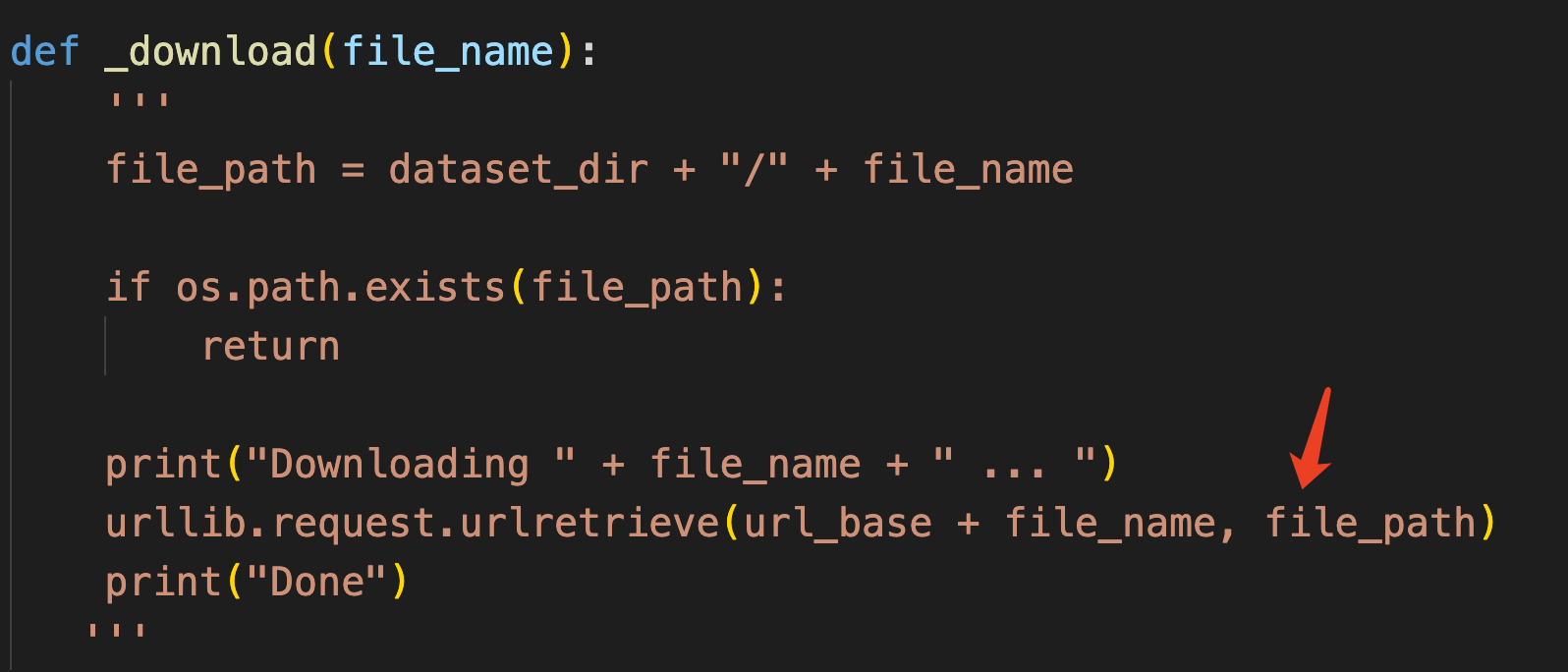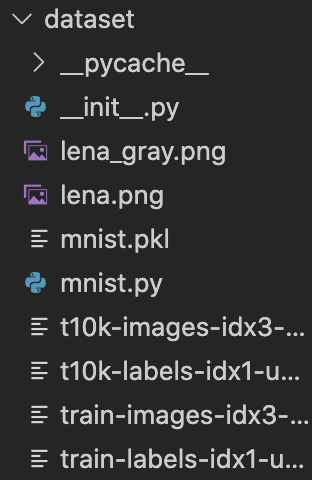加载数据集

原本的minist.py脚本进入到这一行之后一直报503错误,由于我对爬虫类了解不多,最后选择手动下载了minist数据集,再进行处理。

直到这里算是数据加载完成了。

三、神经网络
pickle功能:这个功能可以将程序运行中的对象保存为文件。如果加载保存过的pickle文件,可以立刻复原之前程序中运行的对象。
读取MINST中的数据
不知道是不是sys.path.append(os.pardir)失效了,from dataset.mnist import load_mnist还是不能够找到minist.py,要使用deep_learning_book.dataset.mnist。
import sys, os
sys.path.append(os.pardir) # 为了导入父目录的文件而进行的设定
import numpy as np
from deep_learning_book.dataset.mnist import load_mnist
from PIL import Image # pickle功能
def img_show(img):
pil_img = Image.fromarray(np.uint8(img))#把numpy数组的图像数据转换为PIL的数据对象
pil_img.show()
# (训练图像,训练标签),(测试图像,测试标签)
(x_train, t_train), (x_test, t_test) = load_mnist(flatten=True, normalize=False)
#还可以有第三个参数,one_hot_label=False
#eg.tag=3,one-hot表示为tag=[0,0,0,1,0,0,0,0,0,0]
print(x_train.shape) # (60000, 784) 28*28=784
print(t_train.shape) # (60000,)
print(x_test.shape) # (10000, 784)
print(t_test.shape) # (10000,)
img = x_train[0]
label = t_train[0]
print(label) # 5
print(img.shape) # (784,)
# flatten=True时,读入的图像是以一维numpy数组存储的,显示图像时要恢复成28*28
img = img.reshape(28, 28) # 把图像的形状变为原来的尺寸
print(img.shape) # (28, 28)
img_show(img)
神经网络的推理处理(手写数字的识别)
输入层:784个neuron
隐藏层1:50个neuron (任意设定)
隐藏层2:100个neuron(任意设定)
输入一张图像进行处理:

print(x.shape) # (10000, 784)
print(W1.shape) # (784, 50)
print(W2.shape) # (50, 100)
print(W3.shape) # (100, 10)
sample_weight.pkl中以字典变量的形式保存了weight和bias
import sys, os
sys.path.append(os.pardir) # 为了导入父目录的文件而进行的设定
import numpy as np
import pickle
from deep_learning_book.dataset.mnist import load_mnist
from deep_learning_book.common.functions import sigmoid, softmax
def get_data():
(x_train, t_train), (x_test, t_test) = load_mnist(normalize=True, flatten=True, one_hot_label=False)
return x_test, t_test
# 读入保存在sample_weight.pkl中学习到的权重参数
def init_network():
with open("ch03/sample_weight.pkl", 'rb') as f:
network = pickle.load(f)
return network
def predict(network, x): # 用该函数来进行分类
W1, W2, W3 = network['W1'], network['W2'], network['W3']
b1, b2, b3 = network['b1'], network['b2'], network['b3']
a1 = np.dot(x, W1) + b1
z1 = sigmoid(a1)
a2 = np.dot(z1, W2) + b2
z2 = sigmoid(a2)
a3 = np.dot(z2, W3) + b3
y = softmax(a3)
return y # 返回0~9这十个数字的概率
x, t = get_data()
network = init_network()
accuracy_cnt = 0
for i in range(len(x)):
y = predict(network, x[i])
p= np.argmax(y) # 获取概率最高的元素的索引
if p == t[i]:
accuracy_cnt += 1
print("Accuracy:" + str(float(accuracy_cnt) / len(x)))
批处理
打包输入多张图像,进行并行处理:

x, t = get_data()
network = init_network()
batch_size = 100 # 批数量
accuracy_cnt = 0
for i in range(0, len(x), batch_size):
x_batch = x[i:i+batch_size]
y_batch = predict(network, x_batch)
p = np.argmax(y_batch, axis=1)
accuracy_cnt += np.sum(p == t[i:i+batch_size])
print("Accuracy:" + str(float(accuracy_cnt) / len(x)))
参数axis=1 指定了在100*10的数组中,沿着第1维方向找到值最大的元素的索引。
np.sum(y==t) 用来统计数组中为True的元素个数。
import numpy as np
x=np.array([[0.1,0.8,0.1],
[0.3,0.1,0.6],
[0.2,0.5,0.3],
[0.8,0.1,0.1]])
y=np.argmax(x,axis=1)
print(y)
# [1 2 1 0]
t=np.array([1,2,0,0])
print(y==t) # [ True True False True]
ans=np.sum(y==t)
print(ans) # 3
四、神经网络的学习
梯度
f ( x 0 , x 1 ) = x 0 2 + x 1 2 f(x_0,x_1)=x_0^2+x_1^2 f(x0,x1)=x02+x12的梯度法更新过程:

import numpy as np
import matplotlib.pylab as plt
from gradient_2d import numerical_gradient
def gradient_descent(f, init_x, lr=0.01, step_num=100):
x = init_x
x_history = []
for i in range(step_num):
x_history.append( x.copy() )
grad = numerical_gradient(f, x)
x -= lr * grad
return x, np.array(x_history)
def function_2(x):
return x[0]**2 + x[1]**2
init_x = np.array([-3.0, 4.0])
lr = 0.1
step_num = 20
x, x_history = gradient_descent(function_2, init_x, lr=lr, step_num=step_num)
plt.plot( [-5, 5], [0,0], '--b')
plt.plot( [0,0], [-5, 5], '--b')
plt.plot(x_history[:,0], x_history[:,1], 'o')
plt.xlim(-3.5, 3.5)
plt.ylim(-4.5, 4.5)
plt.xlabel("X0")
plt.ylabel("X1")
plt.show()
神经网络的梯度
# functions
import numpy as np
def identity_function(x):
return x
def step_function(x):
return np.array(x > 0, dtype=np.int)
def sigmoid(x):
return 1 / (1 + np.exp(-x))
def sigmoid_grad(x):
return (1.0 - sigmoid(x)) * sigmoid(x)
def relu(x):
return np.maximum(0, x)
def relu_grad(x):
grad = np.zeros(x)
grad[x>=0] = 1
return grad
def softmax(x):
if x.ndim == 2:
x = x.T
x = x - np.max(x, axis=0)
y = np.exp(x) / np.sum(np.exp(x), axis=0)
return y.T
x = x - np.max(x) # 溢出对策
return np.exp(x) / np.sum(np.exp(x))
def mean_squared_error(y, t):
return 0.5 * np.sum((y-t)**2)
def cross_entropy_error(y, t):
if y.ndim == 1:
t = t.reshape(1, t.size)
y = y.reshape(1, y.size)
# 监督数据是one-hot-vector的情况下,转换为正确解标签的索引
if t.size == y.size:
t = t.argmax(axis=1)
batch_size = y.shape[0]
return -np.sum(np.log(y[np.arange(batch_size), t] + 1e-7)) / batch_size
def softmax_loss(X, t):
y = softmax(X)
return cross_entropy_error(y, t)
# gradient
import numpy as np
def _numerical_gradient_1d(f, x):
h = 1e-4 # 0.0001
grad = np.zeros_like(x)
for idx in range(x.size):
tmp_val = x[idx]
x[idx] = float(tmp_val) + h
fxh1 = f(x) # f(x+h)
x[idx] = tmp_val - h
fxh2 = f(x) # f(x-h)
grad[idx] = (fxh1 - fxh2) / (2*h)
x[idx] = tmp_val # 还原值
return grad
def numerical_gradient_2d(f, X):
if X.ndim == 1:
return _numerical_gradient_1d(f, X)
else:
grad = np.zeros_like(X)
for idx, x in enumerate(X):
grad[idx] = _numerical_gradient_1d(f, x)
return grad
def numerical_gradient(f, x):
h = 1e-4 # 0.0001
grad = np.zeros_like(x)
it = np.nditer(x, flags=['multi_index'], op_flags=['readwrite'])
while not it.finished:
idx = it.multi_index
tmp_val = x[idx]
x[idx] = float(tmp_val) + h
fxh1 = f(x) # f(x+h)
x[idx] = tmp_val - h
fxh2 = f(x) # f(x-h)
grad[idx] = (fxh1 - fxh2) / (2*h)
x[idx] = tmp_val # 还原值
it.iternext()
return grad
import sys, os
sys.path.append(os.pardir) # 为了导入父目录中的文件而进行的设定
import numpy as np
from deep_learning_book.common.functions import softmax, cross_entropy_error
from deep_learning_book.common.gradient import numerical_gradient
class simpleNet:
def __init__(self):
self.W = np.random.randn(2,3)
def predict(self, x):
return np.dot(x, self.W)
def loss(self, x, t):
z = self.predict(x)
y = softmax(z)
loss = cross_entropy_error(y, t)
return loss
x = np.array([0.6, 0.9])
t = np.array([0, 0, 1])
net = simpleNet()
f = lambda w: net.loss(x, t)
dW = numerical_gradient(f, net.W)
print(dW)
# [[ 0.10221412 0.11690908 -0.2191232 ]
# [ 0.15332117 0.17536362 -0.32868479]]
学习算法的实现(随机梯度下降法)
- 抽取mini-batch(目标是减小mini-batch的损失函数的值)
- 计算梯度(为了减小mini-batch的损失函数的值而求各个权重参数的梯度,梯度表示损失函数的值减小最多的方向)
- 更新参数(权重参数沿梯度方向进行微小更新)
- 重复上述步骤
# TwoLayerNet类的实现
import sys, os
sys.path.append(os.pardir) # 为了导入父目录的文件而进行的设定
from deep_learning_book.common.functions import *
from deep_learning_book.common.gradient import numerical_gradient
class TwoLayerNet:
def __init__(self, input_size, hidden_size, output_size, weight_init_std=0.01):
# 初始化权重
# weight使用符合高斯分布的随机数进行初始化,bias用0进行初始化
self.params = {
}
self.params['W1'] = weight_init_std * np.random.randn(input_size, hidden_size) # 第一层的weight
self.params['b1'] = np.zeros(hidden_size) # 第一层的bias
self.params['W2'] = weight_init_std * np.random.randn(hidden_size, output_size) # 第二层的wight
self.params['b2'] = np.zeros(output_size) # 第二层的bias
def predict(self, x): # x是图像数据,进行正向识别(推理)
W1, W2 = self.params['W1'], self.params['W2']
b1, b2 = self.params['b1'], self.params['b2']
a1 = np.dot(x, W1) + b1
z1 = sigmoid(a1)
a2 = np.dot(z1, W2) + b2
y = softmax(a2)
return y
# x:输入数据, t:监督数据
def loss(self, x, t): # x是图像数据,t是正确解标签,进行损失函数值的计算
y = self.predict(x)
return cross_entropy_error(y, t)
def accuracy(self, x, t): # 计算识别精度
y = self.predict(x)
y = np.argmax(y, axis=1)
t = np.argmax(t, axis=1)
accuracy = np.sum(y == t) / float(x.shape[0])
return accuracy
# x:输入数据, t:监督数据
def numerical_gradient(self, x, t): # 计算权重参数的梯度
loss_W = lambda W: self.loss(x, t)
grads = {
}
grads['W1'] = numerical_gradient(loss_W, self.params['W1']) # 第一层weight的梯度
grads['b1'] = numerical_gradient(loss_W, self.params['b1']) # 第一层bias的梯度
grads['W2'] = numerical_gradient(loss_W, self.params['W2'])
grads['b2'] = numerical_gradient(loss_W, self.params['b2'])
return grads
def gradient(self, x, t): # 用误差反向传播高效计算梯度
W1, W2 = self.params['W1'], self.params['W2']
b1, b2 = self.params['b1'], self.params['b2']
grads = {
}
batch_num = x.shape[0]
# forward
a1 = np.dot(x, W1) + b1
z1 = sigmoid(a1)
a2 = np.dot(z1, W2) + b2
y = softmax(a2)
# backward
dy = (y - t) / batch_num
grads['W2'] = np.dot(z1.T, dy)
grads['b2'] = np.sum(dy, axis=0)
da1 = np.dot(dy, W2.T)
dz1 = sigmoid_grad(a1) * da1
grads['W1'] = np.dot(x.T, dz1)
grads['b1'] = np.sum(dz1, axis=0)
return grads
基于测试数据的评价

通过反复学习可以使损失函数对训练数据的某个mini-batch的损失函数逐渐减小,我们还需要确认在其他数据集上也有同等程度的表现,需要判断是否会出现过拟合。
神经网络学习的最初目标是掌握泛化能力(即必须使用不包含在训练数据中的数据),这里我们通过定期(一个epoch)记录训练数据和测试数据的识别精度来进行观察。(没必要每次记录,只要掌握大致趋势即可,所以用epoch)
一个epoch表示学习中所有训练数据均被使用过一次的更新次数。
eg.对于10000个训练数据,用大小为100的mini-batch进行学习时,重复随机梯度下降法进行100次,就可认为所有训练数据都被使用过了,这里的epoch=100。


随着epoch的前进(学习的进行)识别精度都有提高,且实验结果表明训练精度和测试精度几乎一致,说明没有发生过拟合现象。
import sys, os
sys.path.append(os.pardir) # 为了导入父目录的文件而进行的设定
import numpy as np
import matplotlib.pyplot as plt
from deep_learning_book.dataset.mnist import load_mnist
from two_layer_net import TwoLayerNet
# 读入数据
(x_train, t_train), (x_test, t_test) = load_mnist(normalize=True, one_hot_label=True)
network = TwoLayerNet(input_size=784, hidden_size=50, output_size=10)
iters_num = 10000 # 适当设定梯度法的更新次数,每更新一次,都对训练数据计算损失函数值,并添加到数组中
train_size = x_train.shape[0]
batch_size = 100 # 每次从60000个训练数据中随机选取100个数据(图像数据和正确解标签)
learning_rate = 0.1
train_loss_list = [] # 用来记录损失函数值
train_acc_list = [] # 用来记录训练数据集的识别精度
test_acc_list = [] # 用来记录测试数据集的识别精度
iter_per_epoch = max(train_size / batch_size, 1) # 每过这么多次梯度下降就进入一个新epoch,minist数据集60000/100=600
for i in range(iters_num): # 循环次数上限10000 /600 =17次输出识别精度
# 获取mini-batch
batch_mask = np.random.choice(train_size, batch_size)
x_batch = x_train[batch_mask]
t_batch = t_train[batch_mask]
# 用误差反向传播算法高效计算梯度
#grad = network.numerical_gradient(x_batch, t_batch)
grad = network.gradient(x_batch, t_batch)
# 更新参数
for key in ('W1', 'b1', 'W2', 'b2'):
network.params[key] -= learning_rate * grad[key]
# 计算损失函数值,并记录在数组中
loss = network.loss(x_batch, t_batch)
train_loss_list.append(loss)
# 计算每个epoch的识别精度,并存储在数组中
if i % iter_per_epoch == 0:
train_acc = network.accuracy(x_train, t_train)
test_acc = network.accuracy(x_test, t_test)
train_acc_list.append(train_acc)
test_acc_list.append(test_acc)
print("train acc, test acc | " + str(train_acc) + ", " + str(test_acc))
# 绘制图形
markers = {
'train': 'o', 'test': 's'} # 设置线条颜色
x = np.arange(len(train_acc_list))
plt.plot(x, train_acc_list, label='train acc')
plt.plot(x, test_acc_list, label='test acc', linestyle='--')
plt.xlabel("epochs")
plt.ylabel("accuracy")
plt.ylim(0, 1.0)
plt.legend(loc='lower right')
plt.show()
五、误差反向传播算法
误差反向传播算法的实现
前提
神经网络中有合适的weight和bias,调整w和b以便拟合训练数据的过程称为学习。分为以下4个步骤:
- 抽取mini-batch(目标是减小mini-batch的损失函数的值)
- 计算梯度(为了减小mini-batch的损失函数的值而求各个权重参数的梯度,梯度表示损失函数的值减小最多的方向)
- 更新参数(权重参数沿梯度方向进行微小更新)
- 重复上述步骤
# Two_layer_net 组装层版本
import sys, os
sys.path.append(os.pardir) # 为了导入父目录的文件而进行的设定
import numpy as np
from deep_learning_book.common.layers import *
from deep_learning_book.common.gradient import numerical_gradient
from collections import OrderedDict
class TwoLayerNet:
def __init__(self, input_size, hidden_size, output_size, weight_init_std = 0.01):
# 初始化权重
self.params = {
}
self.params['W1'] = weight_init_std * np.random.randn(input_size, hidden_size)
self.params['b1'] = np.zeros(hidden_size)
self.params['W2'] = weight_init_std * np.random.randn(hidden_size, output_size)
self.params['b2'] = np.zeros(output_size)
# 生成层
self.layers = OrderedDict()
self.layers['Affine1'] = Affine(self.params['W1'], self.params['b1'])
self.layers['Relu1'] = Relu()
self.layers['Affine2'] = Affine(self.params['W2'], self.params['b2'])
self.lastLayer = SoftmaxWithLoss()
def predict(self, x):
for layer in self.layers.values():
x = layer.forward(x)
return x
# x:输入数据, t:监督数据
def loss(self, x, t):
y = self.predict(x)
return self.lastLayer.forward(y, t)
def accuracy(self, x, t):
y = self.predict(x)
y = np.argmax(y, axis=1)
if t.ndim != 1 : t = np.argmax(t, axis=1)
accuracy = np.sum(y == t) / float(x.shape[0])
return accuracy
# x:输入数据, t:监督数据
def numerical_gradient(self, x, t):
loss_W = lambda W: self.loss(x, t)
grads = {
}
grads['W1'] = numerical_gradient(loss_W, self.params['W1'])
grads['b1'] = numerical_gradient(loss_W, self.params['b1'])
grads['W2'] = numerical_gradient(loss_W, self.params['W2'])
grads['b2'] = numerical_gradient(loss_W, self.params['b2'])
return grads
def gradient(self, x, t): # 用误差反向传播高效计算梯度
# forward
self.loss(x, t)
# backward
dout = 1
dout = self.lastLayer.backward(dout)
layers = list(self.layers.values())
layers.reverse() # 逆序调用各层
for layer in layers:
dout = layer.backward(dout)
# 设定
grads = {
}
grads['W1'], grads['b1'] = self.layers['Affine1'].dW, self.layers['Affine1'].db
grads['W2'], grads['b2'] = self.layers['Affine2'].dW, self.layers['Affine2'].db
return grads
将神经网络的层保存为OrderedDict(有序字典),它可以记住向字典里添加元素的顺序。
正向传播只需要按照添加元素的顺序调用各层的forward()方法就可以完成处理反向传播只需要按照相反的顺序调用各层即可
Affine层和ReLU层内部会正确处理正向传播和反向传播,所以这里要做的仅仅是以正确顺序连接各层,再按顺序(或逆序)调用各层。
这样只需要不断添加必要的层就可以组装新的神经网络了。
使用误差反向传播法的学习
代码同上一节。
梯度确认
- 基于数值微分的方法
numerical_gradient(),简单耗时,不易出错。 - 解析性地求解数学式,误差反向传播法
gradient(),即使存在大量参数,也可以高效计算梯度。
常用数值微分来确认误差反向传播算法的实现是否正确。
# gradient_check
import sys, os
sys.path.append(os.pardir) # 为了导入父目录的文件而进行的设定
import numpy as np
from deep_learning_book.dataset.mnist import load_mnist
from two_layer_net import TwoLayerNet
# 读入数据
(x_train, t_train), (x_test, t_test) = load_mnist(normalize=True, one_hot_label=True)
network = TwoLayerNet(input_size=784, hidden_size=50, output_size=10)
x_batch = x_train[:3]
t_batch = t_train[:3]
grad_numerical = network.numerical_gradient(x_batch, t_batch)
grad_backprop = network.gradient(x_batch, t_batch)
for key in grad_numerical.keys():
diff = np.average( np.abs(grad_backprop[key] - grad_numerical[key]) )
print(key + ":" + str(diff))
# W1:3.2932210651190824e-10
# b1:2.267204786130569e-09
# W2:4.2147626043734185e-09
# b2:1.3984393797961126e-07